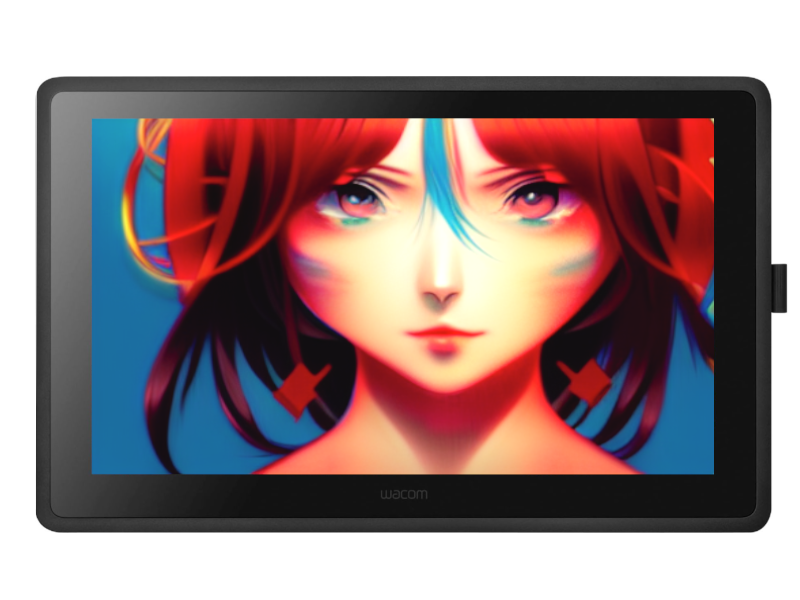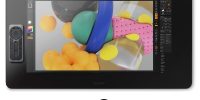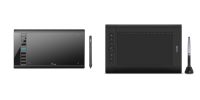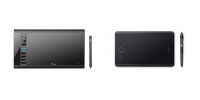Frequently Asked Questions About Drawing Tablets

Pen tablet vs. Pen display: what’s the difference?
A pen tablet is an input device that allows a user to draw using a stylus with a flat, rectangular surface. They do not have a screen; you use your computer’s monitor to view your work.
A pen display, on the other hand, is an all-in-one device that has a display screen. The display area has a pressure-sensitive surface that allows the user to draw directly on the screen using a stylus.
Is a drawing tablet the same as a regular tablet?
No, a drawing tablet (pen tablet and pen display) is a specialized device that is used for drawing digital art. A regular tablet (Android or iPad) is designed for general-purpose tasks like browsing the web, playing mobile games, watching movies, and other computing tasks by installing necessary apps. While a regular tablet can be a good option for drawing, they are usually limited in terms of precision and capabilities.
How do drawing tablets work?
Drawing tablets have sensors that detect the position, pressure, and sometimes the angle or tilt of the stylus on the tablet’s drawing surface. It continuously sends that information to the computer to generate pixels with the correct intensity and thickness in the drawing software. Some drawing tablets also have customizable shortcut buttons and dials to adjust parameters and change active tools for easier use.
Can you use a drawing tablet without a computer?
There are some high-end standalone drawing tablets that can be used without a computer. They are a combination of a drawing tablet and a computer, complete with its own operating system and processing capabilities. For example, Wacom Mobile Studio Pro is a standalone drawing tablet on which you can install drawing applications.
How much does a good pen display cost?
The cost of a pen display (graphics tablet with an integrated screen) can vary widely depending on the features and quality of the device. Entry-level pen displays can cost as little as $200, while high-end models from Wacom Cintiq Series can cost several thousand dollars. If you’re just starting out with digital art, you might want to consider a more budget-friendly option.
Are pen displays better than pen tablets?
This is a hard question to answer. Both types have their pros and cons, and which one is “better” for you will depend on your specific needs and use case. Here are some potential pros and cons of each type of device to help you:
Pen tablets (no-screen):
Pros:
- They are less expensive in general
- Lightweight and more portable
- Can be used with any computer
Cons:
- You cannot see the cursor or the drawing canvas directly under the pen
- It requires patience and practice to develop the necessary hand-eye coordination for accurate use
Pen display (screen):
Pros:
- You draw directly on the screen
- You can see the cursor and your work under the stylus in real-time
Cons:
- They are in general more expensive than pen tablets
- They are heavier and less portable
Do drawing tablets feel like paper?
Some models come with a paper-like textured surface to simulate the feel of drawing on paper. There are also some models like Wacom Intuos Pro Paper Edition which allows you to put a piece of paper on its surface and draw using an actual pen with real ink while the device captures your drawing.
Can you use your iPad as a drawing tablet, and is it enough for drawing?
Yes, you can use your iPad as a drawing tablet, but the drawing experience may not be as good as that on a dedicated high-quality drawing tablet.
What are the advantages of a graphics tablet over a mouse?
- Some of the advantages of using a graphics tablet over a mouse include:
- A stylus can provide more precise drawing control than a mouse, once you are accustomed to using it
- A graphics tablet has pressure sensitivity, unlike a mouse. With pressure sensitivity, the harder you press down the pen, the thicker and darker the lines become.
- Graphics tablets usually come with a stylus that can sense the tilt angle, which affects the appearance of the strokes.
- Drawing with a graphics tablet is more comfortable than using a mouse.
Is it hard to draw on a drawing tablet without a screen?
It may take some time to get accustomed to drawing on a tablet without a screen since you are not able to see the cursor or your work on the drawing surface directly. However, with practice and patience, you will develop your hand-eye coordination and become proficient at it in a short time.
What program do people use with drawing tablets?
There are many programs that can be used with a drawing tablet.
Some of the popular software are:
- Adobe Photoshop
- Corel Painter
- Affinity Photo
- Clip Studio Paint
- Gimp
- Artweaver




